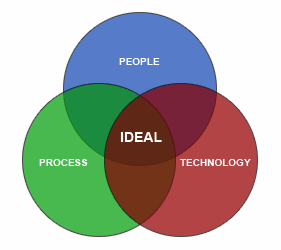Yesterday, I attended Forrester’s inaugural CIO-CMO Forum. Sharyn Leaver, one of the hosts from Forrester, kicked off the event by saying, “This is the first time we’ve brought CIOs and CMOs together in the same room — hope everyone comes out alive.”
Nervous laughter.
And so began a fascinating day of joint CIO-CMO sessions, with more than its fair share of jokes about IT and marketing stereotypes: marketing is nothing but spin and fluff, and IT is a bunch of obstinate snails.
At least I think they were joking.
Forrester’s motivation for bringing these two houses, alike in dignity, together — yes, reference was made to Montagues and Capulets — is what they see as a singular, critical inflection point in business: we have officially entered the Age of the Customer.
Only organizations that are customer-obsessed will lead in this next era, with a blend of marketing and technology that must be seamless to the outside world.
There were many great presentations at the event, and even more interesting conversations on the side. I think the best way to summarize the event is to share with you my list of top 10 memorable quotes — from the stage and from the bleachers — that convey much of the story-in-progress in marketing and IT:
1. “I feel more like a CIO than a CMO! I have marketing automation, CRM, listening platforms — I’m up to my eyeballs in technology.”
This quote from a CMO pretty much sums up the state of modern marketing — and both the excitement and frustration it engenders. Marketing is now effectively a technology-powered discipline, but for many marketing leaders and their departments, it still feels like they’re strangers in a strange land.
2. “Our marketing automation vendor really gets what we do, talks our language about lead flow, nurturing pipeline, campaign analysis. IT just doesn’t get that.”
So when it comes to marketing technology, who you goin’ call? According to Forrester, if you’re a marketing executive, you’re likely to turn to your interactive agency (49%) or a marketing software provider (44%), not just your company’s IT department (55%).
One CMO of a large technology company summed up this dynamic with the quote above — the vendor talks his language, addresses his needs, services him like a prized customer. Because to them, he is a prized customer — and that’s not the kind of love he feels from IT.
3. “If I’m the CMO, and I can get a SaaS product for $100K, but the CIO wants me to ‘buy’ a solution from IT for $300K, what gives?”
But it’s not just language and love that pushes CMOs to look beyond IT. In organizations where chargebacks from IT to the business exist in some form or another — and if they didn’t, how else would you know how to prioritize the unlimited demand for features? — marketing often finds that they can get better prices from outside vendors. “It’s not personal, it’s business.”
Of course, IT counters that sometimes those outside prices are so low because they fail to provide the nice-to-haves — you know, like redundancy, data security, disaster recovery, uptime, etc.
But other times the cloud is both cheaper and better, thanks to economies of scale and specialization. And, as one marketer characterized the chargebacks from IT, “We need to add a single field to a database, and we’re told it’s going to be $90K, which we know is bull$%*#!” As marketers become more savvy buyers of technology, both internally and externally, these arguments will eventually reduce to real cost-benefit analysis — which is where they should be.
4. “I’m building my own pseudo-IT organization in marketing. I call it ‘marketing operations.'”
So confessed one CMO, “It’s what I need to do to get things done.” Depending on who you talked with at the CIO-CMO forum, this was either a progressive move forward with the new reality of marketing or a blatant example of shadow IT. Probably both.
There seemed to be universal consensus that organizations need marketing-savvy people in IT and technology-savvy people in marketing, who the CIO from Aetna referred to as “professional collaborators.” But when you dig into the nitty-gritty of who does what in marketing, in IT, or in some third hybrid group, opinions still run the gamut.
5. “We propose that you need to merge IT and marketing. Have we got your attention?”
Two of my favorite analysts, Luca Paderni (CMO practice) and Nigel Fenwick (CIO practice), launched their afternoon keynote with that bold proclamation. Talk about a great way to shake that audience out of a post-lunch lull.
Actually, it turns out the full-blown merger suggestion was mostly for shock value — although, in my opinion, it may have been the most prescient remark of the day — but they did propose making real, structural changes to enable marketing and IT to collaborate.
They shared a case study from Supervalu, where IT and marketing formed a joint team, staffed it with people who understood both technology and marketing, co-located, shared budget responsibility, and adopted matrix reporting back up to both the CIO and CMO.
Earlier this week, analyst Rob Brosnan presented at IBM’s Smarter Commerce Global Summit on the topic of the rise of the chief marketing technologist (how could I not love that?), recommending that companies form a centralized office of marketing technology to effectively achieve just such a “merger.” Now we’re talking…
6. “IT has been increasingly embracing agile methodologies, and now we’re seeing marketing adopt agile practices too.”
Luca and Nigel continued their presentation by emphasizing agility as the key shift in process required. The part of this that I found most interesting was the nod to agile marketing — running the marketing organization using an adapted agile methodology.
They described a case study where IT and marketing jointly agreed that any proposed project needed to be able to generate value within a 90 day horizon. Projects larger than that were broken up into smaller steps, no more than 90 days each. This encouraged much more rapid feedback cycles, productive tests and prototypes, and generally facilitated much greater innovation between the teams. No more death marches on multi-year projects that end up being DOA.
Their advice in short: “Use Agile for speed. Rethink governance. Plan for fast failure.”
7. “Technology is not an expense, it is a capability for competitive advantage.”
The next CMO up on stage made this remark, and I thought it brilliantly framed why marketing is — and should be — inexorably bound up in technology. It’s not because marketing wants IT’s job. It’s because in a world where digital experiences define the majority of touchpoints businesses now have with customers, to win and retain them, to differentiate from the competition, marketing must wield these new capabilities deftly and creatively.
In Sharyn’s opening remarks, she suggested that in this new Age of the Customer, the companies who are setting the bar are Facebook, IBM, Apple. “Customers are much more tech-savvy, complex, and empowered.” Is your marketing ready to compete at that level?
8. “I will never be as fast as my CMO would like…”
So said the CIO who was on stage with the CMO who made the previous remark. But his point was this: if he were able to easily meet all of the CMO’s demands, then the CMO probably wasn’t being visionary enough.
The digital landscape of customer experiences is evolving at a break-neck pace. A big part of the governance of marketing and technology is balancing two truths: (a) there are always new innovations we should be pushing to test and adopt; (b) we can’t do everything, so we have to make strategic choices about what to prioritize. We have to be comfortable managing this dynamic at the redline.
9. “We don’t know what will make a better customer experience, but we’re data-driven: we constantly test, learn, improve, refine.”
An audience member asked that CMO and CIO duo how they knew what would make a better customer experience. The CMO replied with the above quote.
Experimentation, innovation, iteration, agile practices… these concepts kept recurring throughout the day, from one speaker to the next. The cheaper, faster, easier it can be to prototype ideas and turn to the outside world of the customer for validation (rather than the inside world of the HiPPO), the better companies will be able to thrive in this new Age of the Customer.
Don’t guess, test.
10. “Previously, we had not considered marketing to be an enterprise process, like supply chain management…”
Jeanette Horan, VP and CIO of IBM, made this remark, talking about how their company had turned marketing into a service, similar to how IT is a service in many other organizations. Their realization was that there are a tremendous number of “operations” patterns emerging in the dynamics of the new marketing.
I think this is a stand-alone justification for marketing operations — not as a euphemism for a shadowy pseudo-IT team, but as a key function of modern marketing. The fact that it is technology-powered shouldn’t overshadow the main point that it’s marketing operations — the technology is a means, not an end unto itself. But to try to artificially divide the technology from the process seems like trying to deconstruct a cake: the stand-alone eggs, flour, and sugar arranged on a plate just aren’t as appetizing.





There is more and more a tension between IT and Marketing. New tools put IT prowess in marketers’ hands. The quotes from the CIO-CMO Forum show us an emerging strength in marketing. But IT is our friend in the process. They just need to realize that they can materially impact revenue in the enterprise. Marketing is a way IT can assert itself as a profit center, not just a utility. Great quotes.